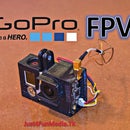Introduction: Finding (Salvaging) Components
I have found that the best (most economical and readily available) source for components is scrap printers. Printers have LCD displays, stepper motors, DC motors, MOSFETS, switches, temperature and humidity sensors, servos, solenoids, electrical wire, lasers, mirrors, light sensors, LED's, Gears, springs, wheels, screws, magnets and a lot of other useful components to start experimenting with micro-contollers.
A huge thank you to instructables, autodesk, MediaTek, and Penolopy Bulnick for sending me the Link It One used in this instructable.
Check Out Our Other Accounts! Like, Subscribe, and Follow to keep up to date with our latest projects. :-)
Step 1: The Manual
The service manual is your best friend for this intractable. Most can be found online in searchable PDF's with wiring diagrams, some even have zoomable 3D models. This makes the teardown much easier as you know exactly where to look for the useful and valuable components and which screws and clips to remove to access them.
Step 2: A Word of Warning
This process will be inexpensive but it will be tedious. service manuals are full of errors, so you may spend time searching for non existent components or screws. Or even more annoy looking for that one screw in the access panel that was left off of the diagram.
I believe that the last words of this dying printer speak volumes. Patience will pay off, using a screw driver instead of a crow bar or hammer will greatly reduce the risk of damaging the components you are trying to salvage and possibly injuring yourself. Also double check the circuit diagrams before you start cutting out or desoldering components.
If you do not understand wiring diagrams or know how to spot electrical components such as capacitors (pictured above) you MUST discharge them before salvaging the circuit boards or you risk electrical shocks (no fun at all). Usually the larger the capacitor more dangerous, but always check the circuit diagrams.
Step 3: LCD Displays
Most printers contain a backlit LCD display, some models include multi colour backlights and notification LED's
Step 4: Gears, Gears, and More Gears
I had no ideas how intricate the drive train of modern printers were. If you follow the gears you will eventually find a motor.
Step 5: Motors
Printers use three main types of motors, steppers (fine movement control), DC (high rate of speed), or servos (DC motors with sensors). Printers mostly contain Steppers and servos but older and larger printers will still use DC motors with external sensors.
Stepper motors use pairs of electromagnets and have 4-8 wires depending on their magnet configuration (look this up in the manga an make note of it). Without the wiring configuration you will either need to do a lot of experimentation or take the motor apart to figure out how to properly control it. Otherwise it will just do the funky chicken and twitch instead of turn. For more information on Stepper motors and how to control them using a micro-controller click here: https://www.instructables.com/id/Stepper-Controller/
Brushless DC motos and quite common in printers and are heavily geared. The bonus of this long drivetrain is that there are a lot of gears of the same teeth that fit the worm gear on the motor. DC motors work by changing the polarity of electromagnets in the stator around a circular pattern causing the exterior casing of the brushless motor to rotate, this helps to maintain the momentum of the drivetrain. For more information on DC motors and how to control them using a micro-controller click here:
Step 6: Solenoids
Solenoids are found in various sizes through the printer and heavily concentrated through the DC motor drivetrain to change the gearing of the printer. They are basically electromagnet with a magnetic shaft.
Solenoids can be used for various projects as quick releases, for small movements, or used as basic electromagnets.
Step 7: MOSFETS
MOSFET are variable resistance switches and are used throughout printers. there are usually somewhere between 25 - 30 MOSFET's per printer. They range from 12v to 110v and 2-50amp.
Step 8: LEDs and Simple Light Sensors
Printers contain many pairs of LED's and simple light sensors (used to detect the position of the paper). These can be useful for adding lights for communication to your projects and for making light sensitive project or photoresists arrays.
Step 9: Switches
Switches can be found throughout printers. Mostly as limit switches for the print heads or used to detect the presence of the paper tray. Although they can also be found used to control the power supply and basic functions such as fans.
Step 10: Lasers
These lasers were salvaged from a laser printer. They are grade 6 non visible lasers (they will burn your retinas without even knowing it), but the optics and mirrors surrounding the lasers are high quality and fun to experiment with (using safe visible lasers and lights).
Step 11: Fans
There are multiple types and grades of fans found in most printers. It is easiest to find them near the lasers on laser printers, or scanners, motors, and other areas prone to overheating.
Step 12: Temperature and Humidity Sensors
When I first started salvaging printers, I never realized how important temperature and humidity were to proper printing. There is a highly accurate temperature and humidity sensor located in a protective metal case surrounded by filters near the print heads, and multiple temperature sensors through the printer. Most of the are analog (voltage resistance) although you will need to consult the service manual to be sure.
Step 13: Flex Sensors
Around the drum of the printer there are ally flex sensors which are used to detect the weight (thickness) of the paper being drawn in from the tray. They are usually analog resistance sensors but this can be determined from the service manual. They are very interesting but I have not yet had a chance to use them in any projects.
Step 14: Magnets
Weak magnets can be found throughout printers to minimize electromagnetic interference from electrical equipment with digital chips. So far they have been fun to play around with, but I have not used them in any practical projects.
Step 15: Control Panels
If your service manual includes basic code response tables you will be able to salvage the control panels from the printer and interpret the data transmitted on the data pins. It is important to label the wires, as voltage applied to the wrong place can cause a lot of damage.
Step 16: Photo Sensors
Printers photo sensors and usually use them to calibrate the brightness scanners. These can be very useful, and I am hoping to use them with some upcoming green energy projects.
Step 17: Scrap Wires
Scrap wire is one of the most widely used and lastly used communities while prototyping and printers are literally full of multiple gauges and colours of copper and aluminum alloy wiring. Also all of the circuit boards have connectors for the corresponding wires, which can be desoldered, and used to neaten up prototypes.
Step 18: Prototyping
The best part is after salvaging an old printer you now have a ton of components to experiment with and have only invested some sweat and time into learning to use micro-contollers. This is especially helpful when trying out new ideas as it greatly reduces the initial investment and wait time (for component delivery) for any project.
If you can think of any other components that I have missed that may be useful to salvage or have any questions feel free to comment below.
Happy tinkering and have a great day! :-)

Participated in the
Leftovers Challenge













![Tim's Mechanical Spider Leg [LU9685-20CU]](https://content.instructables.com/FFB/5R4I/LVKZ6G6R/FFB5R4ILVKZ6G6R.png?auto=webp&crop=1.2%3A1&frame=1&width=306)





